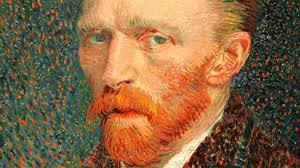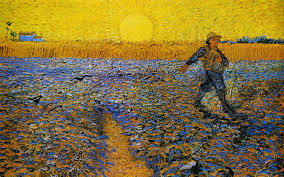Yours truly, Vincent
Yes, we know Vincent Van Gogh cut off a piece of his ear. Not the whole ear, but enough to convince an up-'n'-coming painter named Paul Gauguin to end their friendship in 1888. But how many know he was an accomplished writer?
June 23rd, 2014

"Portrait de L'artist sans Barbe" ("Portrait of the artist without beard") was Van Gogh's last self-portrait. He gave it to his mother for her birthday in 1889. It sold for $100 million in 2012.
By the time Vincent van Gogh died at age thirty-seven in 1890, he had written about one thousand letters, mostly to his brother Theo.
Van Gogh had a sad and depressing life. He was admitted to hospital in Arles in January of 1880. When he was released, local citizens claimed he was unstable and a public risk, so he was apprehended by the local constabulary and re-admitted. Despite recurring epileptic attacks, he continued to paint.
By the time Van Gogh suffered a self-inflicted gunshot wound to his stomach in July of 1890, leading to his death two days later, he had sold precisely one painting in his lifetime–to his long-suffering brother Theo, who was at his bedside when he died.
We know that. But what we didn’t know was that Van Gogh, the eldest of six surviving children, was also a prolific and sophisticated letter writer.
As described in Patrick Grant’s The Letters of Vincent Van Gogh: A Critical Study (Athabasca University Press $27.95), most of his letters (658) were written to Theo; others (21) went to his youngest sister Willemien. Only 39 letters from Theo to Vincent have survived. At least sixteen went to Paul Gauguin. The total number of letters currently known to exist, to and from Van Gogh, is 903. Grant has read them all. He wrote 585 letters in Dutch, 310 in French and six in English.
 As an adjunct to Van Gogh’s legacy of more than 2,000 art works, the letters reveal the painter’s changing opinions with regards to religion — at one point he had resolved to follow in his father’s footsteps and study theology at the University of Amsterdam and the following year he entered a missionary school in Brussels — as well as art.
As an adjunct to Van Gogh’s legacy of more than 2,000 art works, the letters reveal the painter’s changing opinions with regards to religion — at one point he had resolved to follow in his father’s footsteps and study theology at the University of Amsterdam and the following year he entered a missionary school in Brussels — as well as art.
Others have already examined the letters as a window to appreciating Van Gogh’s literary influences. Patrick Grant,as a professor emeritus of English at the University of Victoria, has a somewhat more refined agenda.
 “I am not mainly interested here in the books that Van Gogh read,” Grant writes, “although I acknowledge the part they play in his letters and his deployment of them for rhetorical effect in specific instances. Rather, I am concerned with the literary dynamics and imaginative coherence of Van Gogh’s own writing.”
“I am not mainly interested here in the books that Van Gogh read,” Grant writes, “although I acknowledge the part they play in his letters and his deployment of them for rhetorical effect in specific instances. Rather, I am concerned with the literary dynamics and imaginative coherence of Van Gogh’s own writing.”
The Letters of Vincent van Gogh is therefore a critical study of the painter as a literary artist in terms of his writing abilities and inclinations “not as a footnote to the paintings but as a highly sophisticated literary achievement in its own right.”
BOOKS BY PATRICK GRANT:
Transformation of Sin: Studies in Donne, Herbert, Vaughan and Traherne (University of Massachusetts Press, 1974)
The Letters of Vincent Van Gogh: A Critical Study (Athabasca University Press 2014) $27.95 978-1-9273-5674-6


As I recall Van Gogh died two days, not two years, after he shot himself.
Thanks for catching that error. Corrected.